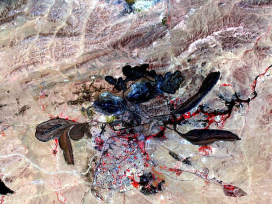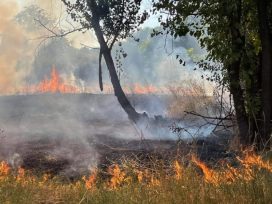The quantification of global environmental threats, such as climate change and the mass extinction of species, was and is essential to assessing the significance of these threats. But the nature of environmental expertise, so far primarily the reserve of the natural sciences, has failed to effect anything resembling the radical change likely to be required in order to avert environmental catastrophe. So, given that expertise is itself a generic category and is mobilized in particular historical periods for particular purposes, it seems prescient to reflect upon alternative approaches to environmental expertise. For if we do in fact find ourselves in the early stages of a new geological period, the Anthropocene, where humans are implicated in all of Earth’s biophysical systems, then clearly, scientific descriptions of environmental phenomena in which people, citizens and society are all too often absent, and the underlying expertise that gives rise to such descriptions, needs reconsidering. We would do well to begin by reflecting upon the concept of “environment” itself.

The Mauna Loa atmospheric observatory in the late afternoon. Photo: LCDR Eric Johnson, NOAA Corps.
The colonization of environmental issues
Despite concepts as crucial as “nature” and “wilderness” receiving special attention from historians, the concept of “environment” is far less commonly subjected to scrutiny. Yet sophisticated ways of conceptualizing and quantifying the human impact on the global environment have become commonplace in today’s discourse. In respect of which, few would dispute the usefulness and scientific soundness of concepts such as “ecological footprint” and the dimensions of “planetary boundaries”. However, it may be that more nuanced interpretations have to be taken account of too, such as those put forward in the humanities, if human behaviour is to change in any kind of meaningful way. In short, this may well mean reconsidering why it is that the formal and quantitative takes precedence over the social and over values.
To which end, a concise history of just how the formal and quantitative came to play a major role in the colonization of environmental issues would certainly be useful. Prior to
the leap in scale from the local to the global that accompanied the arrival of modern climate science and other environmental fields of expertise, a shift in focus away from reconstructing the past to predicting the future had already become apparent. Before the 1920s, the focus of sciences such as geography, geology, biology, ecology and meteorology had been on the present and on the past that had led up to the present and could help explain it. Chronological techniques such as geological stratigraphy, dendro-chronology, pollen, analysis, glacial dynamics and others were used to provide data sets intended to “set the record straight”. These in turn provided a basic platform for what later became predictive environmental expertise.
A decisive shift in focus toward the future came in the interwar years. The futurist Wendell Bell draws attention to the US presidential committees, headed up by sociologist William F. Ogburn, on social and technological trends in the early 1930s as indicative of this development. During the decades following World War II, a range of specialists began “colonizing” the kinds of issues that were later to be called “environmental”, a process in which the emerging discipline of ecology, among others, played a key role. The historical perspective typical of the earth and geophysical sciences before the 1920s gave way to an integrated and future-oriented one, to which human agency was central.
After World War II, Fairfield Osborn’s Our Plundered Planet and William Vogt’s The Road to Survival, both published in 1948, constituted major works in terms of integrating existing issues into a meaningful whole, or what might be called the “modern environmental problem catalogue”. Of these issues, population growth was considered the most pressing. Malthus’ An Essay on the Principle of Population, first published in 1798, had already established concerns over the relation between population, food and resources as part and parcel of the narrative of modernity. By 1927, the pressures that population growth exerted on agricultural capacities was the subject of a World Population Conference in Geneva attended by the likes of John Maynard Keynes. Throughout the mid-twentieth century, new groups of experts confronted these pressures with a combination of calculations of land size, agricultural productivity and predictions of population growth.
Other issues that featured in the “modern environmental problem catalogue” also had distinct histories. The importance of soil quality was mentioned by the Roman writer on agriculture Columella in antiquity and became established as a key issue in the modern period with the advent of major works such as George P. Marsh’s Man and Nature. Thereafter, the American Dust Bowl in the 1930s made soil quality and erosion an issue of world interest but every continent could provide examples. Equally, awareness of species loss was raised by famous cases involving North American bison and the endangered California Condor. But Vogt in particular sought to tie all of these issues together, along with those of water scarcity, overconsumption, overgrazing, pests and industrial wastes, in order to promote the realization “that we live in one world in an ecological – an environmental – sense”.
The collapsing of various issues, each with a diverse genealogy of its own, into “environmental issues” meant that they could be discussed in similar terms and dealt with accordingly, including at a governmental level. Thus, at the end of the 1960s, steps were taken to establish environmental protection agencies in countries such as the United States and Sweden, a trend repeated in the following decades in most industrialized countries. The collection of environmental data was crucial. Just as a nation’s society was “invented” through the aggregation of local statistics as an expression of the “condition of society” from the nineteenth century onward, so the environment was invented in the process of collecting data that expressed measureable and quantitative “conditions of the Earth”, which were increasingly understood in their global dimensions. Indeed, the need for synthesis became increasingly urgent in the face of patterns of co-variation among various conditions of the Earth, whether with regard to erosion, salinization, chemical water and soil pollution or increasing levels of atmospheric carbon dioxide.
Thus, during the course of the second half of the twenty-first century, a notion of the environmental emerged according to which the significance of conditions of the Earth was expressed in numbers and, in this form, integrated into a narrative of humanity’s relation to the Earth. Just as figures concerning population came to be regarded as “social facts”, so did the figures concerning non-human phenomena. However, the production and interpretation of these figures remained more or less exclusively in the domain of certain experts drawn from the natural sciences. And, instead of primarily defining the past or the present, the aim was to be able to supply and apply predictive environmental expertise that would determine the “future of nature” and establish the expert’s predictive authority based on the threat posed by quantifiable change. Indeed, this was the cue for the “meta-specialist” who possessed not only “contributory” but also “interactional” expertise, to use the terminology of Harry Collins and Richard Evans. For many more experts could contribute to their respective fields than could exercise influence over society and policy.
Vogt and Osborn certainly featured among those influential thinkers and communicators who possessed interactional environmental expertise, along with others such as Georg Borgström, Kenneth Boulding and, slightly later, Rachel Carson and Barry Commoner, to name just a few. And the works of Vogt and his followers were full of numbers too, sometimes presented in the form of striking visual representations to make them more easily accessible. Quantifiable science was well on the way to becoming the central knowledge base for the environmental. However, that it ultimately succeeded in this respect was not inevitable, given the social framework of the concept.
The concept came of age on the symbolic level with the UN Conference on the Human Environment in Stockholm in 1972. Thereafter, economists, political scientists and specialists in diplomacy and trade negotiations all entered the environmental realm, albeit still largely serving national interests. The “Global 2000 Report to the President” that Jimmy Carter commissioned in 1977 reads like a single extended sequence of predictions, or “projections” as they are called in the report. These concerned population, GNP, climate, technology, food and agriculture, marine environment, forests, water, energy, minerals, to name only the most significant. As such, the report is a clear marker of the extent to which quantifying and monitoring rates of global change across a wide spectrum of processes had become the order of the day.
Simultaneously, throughout the post-war decades, the ideology of science contributed significantly to a general reluctance to consider environment as a concept of social rather than of natural science. In his book The Honest Broker (2007) Roger Pielke Jr shows how the “Pure Scientist” is content to furnish decision-makers with his judgement-free scientific findings without engaging in any level of synthesis. The predominant mode of proceeding has remained more or less the same since Vannevar Bush described it in his 1945 Report to the President, The Endless Frontier one does one’s “basic” research, publishes one’s results and leaves the consequences for others to think about, along with the “applied” research and policy measures that follow. In contrast to which, Pielke advances the notion of the “Issue Advocate”, who makes (sometimes rather selective) use of scientific findings to support a particular stance – whether environmentalist or anti-environmentalist. An example of the latter would be the hawkish US-American climate sceptics, some whom emerged as such having denied the existence of any connection between smoking and long cancer in the interests of protecting tobacco companies from restrictions. Lastly, in contrast to both the Pure Scientist and the Issue Advocate, the “Honest Broker” in the title of Pielke’s study presents several positions supported by a range of sources – without concealing his own position – so as to allow decision-makers to form their own, informed opinion. However, even if the relation between knowledge and practice is complex and constantly subject to change, the science drawn upon almost invariably remains formal and qualitative.
From the local to the global: Environmental expertise and climate change
The development of frameworks for the collection of geophysical and biological data has a longer history than may be popularly supposed. Alexander von Humboldt advanced his perspective on the potential use of isolines to synthesize data, including that relating to wind patterns, at the beginning of the nineteenth century. By mid-century, Heinrich Wilhelm Dove had proposed the existence of global isotherms and likely used them to show regional variations in temperature. The notion that humans could effect climate change as a result of their use of fossil fuels had already been established in the 1930s by Guy Stewart Callendar but could only be substantiated with the advent of global measurements of atmospheric carbon dioxide being used to model predictions based on secure and continuous data.
However, for at least the first six decades of the twentieth century, climate scientists predominantly focused on local data concerning individual glaciers, the sediments of specific lakes, tree rings, pollen layers or atmospheric carbon dioxide – without advancing any kind of global synthesis. It was not until 1958 that Charles David Keeling started to measure the concentration of atmospheric carbon dioxide at the Mauna Loa Observatory in Hawaii that the current understanding – that carbon dioxide levels change systematically as a consequence of human forcing – became established. It is as a result of measurements, among others, recorded there on a daily basis ever since that we know the concentration of carbon dioxide in the global atmosphere is approaching 400 parts per million (ppm) for the first time in human history. Hence the significance of what became known as the Keeling curve.
This shift in scales, from the local to the global, combined with a period of increasingly sophisticated computer-based modelling and the contributions of large programmes
such as the International Geophysical Year and Global (IGY) of 1957/8 and the Global Atmospheric Research Program (GARP) beginning in 1967 all helped to win recognition of the possibility of human climate forcing. The road to the formation of the United Nations Intergovernmental Panel on Climate Change (IPCC) in 1988 was open and the global role of environmental prediction secured.
The future of nature: Environmental services?
The question remains as to the relation between expertise and policy. Despite the changing face of research across both the natural sciences on the one hand and the humanities and social sciences on the other, precious little has been done to overcome the gap between these groups of disciplines and integrate associated expertise. Perhaps as a result of which, it is not uncommon for people, citizens and societies to be absent from scientific descriptions of environmental phenomena. Equally, the geographies of environmental degradation are all too rarely confronted with questions of equity and justice in mind.
The increasing popularity of the concept of ecosystem services is clearly a phenomena that could benefit from being subjected to scrutiny from the perspective of the environmental humanities and social sciences. The concept has led to the assignment of economic value to resources and processes, or “services”, that ecosystems supply. These may range from drinking water to the pollination of crops or the maintenance of forests in order to maintain watersheds at a certain level. Ecosystem services have become increasingly institutionalized following the completion in 2005 of the United Nations Millennium Ecosystem Assessment, an endeavour involving around 1,360 scientists worldwide. This is a trend that has continued with the establishment of a global network operating under the acronym used to refer to what is intended to become a legitimate aspect of decision-making processes: TEEB, or The Economics of Ecosystems and Biodiversity. And yet, this very approach, which on the surface seems to strengthen the position of ecosystems, suffers from the same shortcomings as many other policy tools designed to deal with environmental impacts: they tend to favour those in possession of economic means such that they can afford to have their needs met even at higher prices.
It is, therefore, all too often the case that, where “technologies of globalization” predominate, cultural and social diversity are sidelined, along with local civic participation; and the wedge that comes between these elements tends to be a highly formalistic form of expertise. This is to say nothing of the implications of the market valuing ecosystem services per se: for should the value be low, this can imperil future generations; if it is high, there is likely to be an equity issue. The figures might appear to those with the expertise to add up, but the ramifications for underlying complexities on the ground are often far from tidy.
Moreover, not only can human and political geographers, and economic and environmental historians, provide expertise on these issues. They can also provide alternatives to predominantly market-based calculations and deepen the analysis of what literary scholar Rob Nixon describes as the “slow violence” that takes place on a daily basis: though no formal legal thresholds seem to be crossed, the rich nonetheless inflict violence on the poor, or violence is directed out of the North at the global South. However, the pace at which such processes take place is simply too slow to end up in the media limelight.
Reconfiguring environmental expertise
Advancements in environmental protection and sustainability currently proceed at a painstakingly slow pace. Scientific and technological solutions are undoubtedly urgently needed but will not be enough without fundamental change in the internal operative mechanisms of societies and economies. The proponents of reliable, globally valid boundaries for societal action on atmospheric carbon dioxide, the nitrogen and phosphorous cycles, biodiversity, freshwater and land use, ocean acidification and ozone depletion deserve all of the attention they have received. But, at the same time, they are part of a larger pattern in which value-based concerns and the social and human aspects of environmental crisis are typically kept at a distance.
The increasing hegemony of formal and quantitative approaches is, however, now being questioned, typically on the basis of interpretive approaches of the social sciences and humanities. Work on the universal singularities of “boundaries” and “services” as well as on “costs”, considers the implications of applying associated methodologies without concern for temporal, geographical or cultural specificities. Attention is being drawn to the geographical and social distribution of environmental impacts and the question of who benefits from which ecosystem services. Some critics look askance at the premises upon which it is suggested that environmental crisis can be dealt with as a problem of global engineering – harking back to Buckminster Fuller’s Operating Manual for Spaceship Earth (1969). The very framing of huge environmental and sustainability challenges seems key to the choice of expertise. Several scholars have observed that the emphasis on formal indicators is rooted in so-called New Public Management, which can pass for an approach (associated with neo-conservative or neo-liberal ideology) aimed at increasing the efficiency of public administration.
In practice, the standardized criteria of experts often means a de-politicization of complex social issues and a shift away from democratic and collective decision-making. Debates on urban environmental issues, for example, become “postpolitical”. This, despite the insistence of leading sociologists of science that nature is in fact and must remain political rather than an apolitical realm sealed off by those with a command of esoteric expertise.
Science can assist but it cannot provide the full answer. We should probe deeper and invite the humanities and social sciences to play a central role in the sustainability endeavour. Climate change is a pertinent example in terms of the benefits on offer in doing so. The climate science might be crystal clear but the reasons for societies around the world failing to take the necessary decisions to halt global warming lie within those in societies, in traditions and in religious, ideological and other values, as well as in views on economic development and personal freedom. In the face of which, the deployment of new kinds of expertise becomes a necessity. Because, at the moment, we face a global predicament where billions have become the victims of climate change largely because of the combined and total impact of humanity, where the wealthy in the global North have consistently contributed most, whilst the unequal distribution of wealth enables the wealthiest (and the most polluting) to escape the consequences of their actions.
The social science, law and humanities disciplines are providing more and more evidence reflecting the many ways in which the environmental, that is, social nature, is
imbued with ideas, values, democratic dilemmas, human greed and fragility. This knowledge will have to be transformed into environmental expertise that can be used in advice and policy in a way that does justice to complexity without sacrificing reflexivity. This will require more research as to what difference knowledge makes and how different kinds of knowledge may affect environmental decision-making. The reconfiguring of environmental expertise has only just begun.








